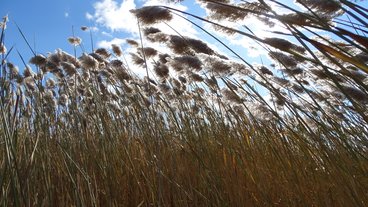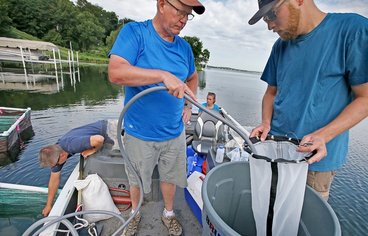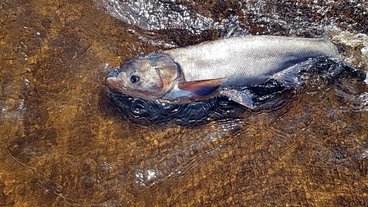
Scientists say there's still time to save Minnesota from invasive wetland plant
An invasive grass is spreading in wetlands across Minnesota, but scientists at the Minnesota Aquatic Invasive Species Research Center say there's still time to stop it in its tracks.
They want the state to get serious about invasive phragmites, an invasive strain of a native wetland grass that grows faster, taller and thicker than its native cousin.

Zebra mussels’ best friend: wakeboard boats, new U study finds. Livewells also tested.
The best way for invasive zebra mussel larvae to get from one Minnesota lake to another is aboard wakeboard boats, a new study has found.
The ballast tanks of recreational wakeboard boats beat out other leading stowaway suspect, including sterndrive inboard/outboard engines, bilges and livewells — all of which can harbor the larvae — according to a study by the University of Minnesota’s Aquatic Invasive Species Research Center.
Moreover, zebra mussel larvae that make their way into wakeboard ballast tanks take longer to die than those that stow away in smaller areas, such as livewells, according to the study, which analyzed water samples from 379 boats on Lake Minnetonka and Gull Lake in Cass County over two years.
In fact, the study found, it looks like standard minimal tactics for reducing zebra mussel spread — cleaning the exterior of a boat and removing the drain plug — won’t be enough for wakeboard boat ballast tanks and some other large-volume water-holding areas. A hot-water flush or five days of drying are the most practical surefire ways to ensure no larvae survive.

Currents: Cori Mattke, associate director, Minnesota Aquatic Invasive Species Research Center
Cori Mattke started last week as associate director of the Minnesota Aquatic Invasive Species Research Center at the University of Minnesota. She previously was associate director of the nonprofit Friends of the Boundary Waters Wilderness.
Reading
I am currently reading two books. The first is “The Hour of Land” by Terry Tempest Williams. Williams is not only one of my favorite authors, she’s one of the most influential voices in my personal and professional life. “The Hour of Land” is a beautiful narrative on the importance of public land. I’m also reading “The Signature of All Things” by Elizabeth Gilbert. Coincidentally, another story of a woman’s connection to the natural world.

U of M to study virus as potential carp control
Of all the aquatic invasive species being studied at the University of Minnesota, there's one that is often forgotten.
"We have common carp in here right now," said Nick Phelps, Director of the Minnesota Aquatic Invasive Species Research Center. "It was introduced in the late 1800's as a food source for European settlers."
The common carp is now more known as a source of destruction to lake vegetation, which is why researchers have spent years looking for ways to control them.
"The one that seems to be rising to the top perhaps is Koi herpes virus," Phelps said.

Minnesota researchers hope to use fish virus against carp
University of Minnesota researchers may be able to use a recent fish virus outbreak to combat an invasive species plaguing state lakes.
Researchers with the university's Minnesota Aquatic Invasive Species Research Center are studying Koi herpesvirus to see if it can be used to control the invasive carp population, Minnesota Daily reported.
"We want to find ways to kill carp and zebra mussels and all these invasive species," said MAISRC Director Nick Phelps. "We started this particular project in 2014 — went two years and didn't see (the virus) anywhere, then saw it in seven to eight lakes in a matter of a month and a half.

U researchers look to harness fish virus in fight against invasive carp
University of Minnesota researchers see a recent fish virus outbreak as a chance to combat an invasive species plaguing state lakes.
Researchers at the University’s Minnesota Aquatic Invasive Species Research Center (MAISRC) in St. Paul have been studying the usage of Koi herpesvirus (KHV) — responsible for recent carp deaths in Minnesota lakes — for potential bio-control of invasive carp. Koi fish are a subspecies of common carp, making them both susceptible to the virus.
“We want to find ways to kill carp and zebra mussels and all these invasive species,” said MAISRC Director Nick Phelps. “We started this particular project in 2014 — went two years and didn’t see [the virus] anywhere, then saw it in seven to eight lakes in a matter of a month and a half.”

Inside a St. Paul lab's battle against aquatic invaders
In a lab on the University of Minnesota's St. Paul campus, bright green plants float in water-filled washtubs beneath glowing fluorescent lights.
Here, researchers are actually trying to grow one of the state's most dreaded aquatic invaders.
"Right here in the middle, we have starry stonewort, which is Minnesota's newest invasive species on the scene," program coordinator Pat Mulcahy said.
Sucking Unwanted Fish Out of Minnesota's Lakes and Rivers May Soon Be a Reality
Imagine a tube that could suck unwanted fish out of Minnesota’s lakes and rivers.
It seems like a bizarre idea. But you might soon see it in practice in the Twin Cities.
On Wednesday, the Aquatic Invasive Species Research Center at the University of Minnesota showcased its research. This is the only time each year all scientists involved in stopping the spread of aquatic invasive species get together to share ideas.

Corps changes operations at Lock and Dam 8 to deter Asian carp invasion
The U.S. Army Corps of Engineers, St. Paul District, recently changed how it operates Lock and Dam 8 on the Mississippi River in Genoa, Wisconsin, in an effort to impede the upstream movement of Asian carp.
The Corps changed the way it operates the spillway gates on this site in response to recommendations from a University of Minnesota research team led by Peter Sorensen. The proposed alterations are the result of several years of study of Asian carp movement and deterrent techniques funded by the Minnesota Environment and Natural Resources Trust Fund. These changes were carefully designed to stop carp passage while having minimal effects on native fish, fishing and lock and dam infrastructure.
"Our research has showed that there were small flow imbalances under prior operating procedures that might have been allowing adult carp to swim through the dam," Sorensen said. "Making relatively small adjustments to gate operations will prevent this without affecting barge traffic and costs nothing."

In effort to stop Asian carp, Army Corps adjusts water flow at Mississippi lock near Iowa border
The U.S. Army Corps of Engineers has adjusted the gates at Lock and Dam 8 on the Mississippi River near the Iowa border to stop the spread of Asian carp, using advice from experts from the University of Minnesota.
The lock and dam is the only one on the Mississippi to be adjusted to fend off the invasive species to date, the corps said in an announcement Wednesday morning.
University of Minnesota Prof. Peter Sorensen, an expert on Asian carp who is advising the corps, said the changes "are a big deal," altering water flow at the dam in a way that prevents carp from passing upriver.
